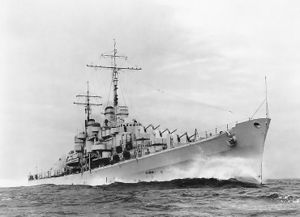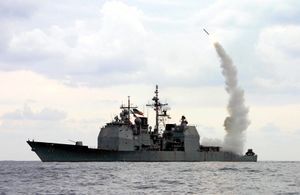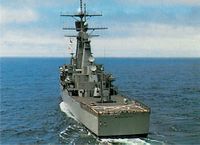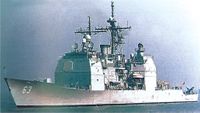طراد
الطراد Cruiser، سفينة حربية كبيرة تستعمل لمرافقة حاملات الطائرات ولتنفيذ العمليات المستقلة مع المدمرات، وتستطيع الطرادات الحديثة، وتسمى طرادات القذائف الموجهة، إطلاق القذائف ضد الطائرات والسفن العائمة وإطلاق قذائف الطوربيد على الغواصات. وتستخدم الطرادات أجهزة الرادار والسونار ومعدات الاعتراض الإلكترونية الأخرى من أجل اكتشاف الطائرات والسفن العائمة والغواصات المعادية.
وتعمل بعض الطرادات بالطاقة النووية حيث تقوم مفاعلات نووية بتوليد القوة البخارية. بينما تعمل طرادات أخرى بالمحركات التوربينية. ويمكن للطرادات أن تبحر بسرعة 30 عقدة تقريبًا.
وخلال الحرب العالمية الثانية (1939- 1945م) اشتبكت الطرادات مع السفن المعادية، كما قصفت الشواطئ لمساندة عمليات الإنزال البرمائية. وفي الثمانينيات لم تكن الطرادات تُبنى سوى فيما كان يعرف بالاتحاد السوفييتي وكذلك الولايات المتحدة.
. . . . . . . . . . . . . . . . . . . . . . . . . . . . . . . . . . . . . . . . . . . . . . . . . . . . . . . . . . . . . . . . . . . . . . . . . . . . . . . . . . . . . . . . . . . . . . . . . . . . . . . . . . . . . . . . . . . . . . . . . . . . . . . . . . . . . . . . . . . . . . . . . . . . . . . . . . . . . . . . . . . . . . . .
التسمية
كان اسم الطراد يطلق على الفرقاطات مع بداية استخدام القوة المحركة البخارية، إذ إن التسمية الحرفية للطَّرَّاد تعني المطاردة، أو السفينة الجوالة التي تجوب البحار لقنص السفن المعادية والغواصات في أعالي البحار.
التاريخ
بنت البحرية البريطانية أول طرَّاد حديث عام 1880، وكان الاتجاه المبدئي لتطوير الطرَّاد ينحصر في تصفيح سطحه فولاذياً بسماكة 50ـ100مم، لحماية غرف المحركات والمخازن، إضافة إلى زيادة السرعة، ومرونة الحركة، وتسليحه بقدرة تدميرية جيدة، بكلفة مادية أقل من البارجة، فضلاً عن ثبات واستقرار نسبيين في البحر. ثم صار جسم الطَّرَّاد مغزلياً انسيابياً مسطحاً من الأعلى، وطوله عشرة أضعاف عرضه. ويراوح طول الطراد الحديث بين 160و200م وعرضه بين 16و20م، وغاطسه في الماء يراوح بين ثلث ونصف عرضه. يُبْنَى الطَّرَّاد من مقاطع كتيمة عدة، ويتألف من طوابق وأسطح عدة، ويكون معظم تسليحه على السطح العلوي غالباً، وتكون منشآت القيادة والمداخن والهوائيات في المنتصف، وحيِّز استقبال الحوَّامات في سطح المؤخرة. ويمتاز الطَّرَّاد بثباته في الماء وسرعة مناورته وقدرته الفائقة على الدفاع الذاتي وعن السفن التي يرافقها.
الطرادات من 1919-1945
أقرت الولايات المتحدة الأمريكية هذا الصنف من السفن بعد عام 1922، بإزاحة لم تتجاوز مبدئياً 10 آلاف طن، ثم زادت فيها. وأبقت الحرب العالمية الثانية التسليح المدفعي ولكن مع ازدياد قدرة الغواصات والطائرات وحاملات الطائرات على التدمير. اقتصر أثر الطرَّ ادات في حماية القوافل ومرافقة حاملات الطائرات والمجموعات القتالية، وحماية طرق المواصلات، وأضيفت إليه حماية الإنزالات البحرية والقوات العاملة على الاتجاه، مما أعطى الطَّرَّادات أهمية إضافية، فزيد في قوتها النارية، وزوِّدت بالأسلحة المضادة للغواصات والمضادة للطائرات.[1]
الطرادات المضادة للطائرات
غير أن تنامي فاعلية الطيران والأسلحة الجوية قَصَرَ أهمية الطَّرَّاد الأساسية على قدرته القتالية وبقائه الطويل في البحر وثباته القتالي، وبرهنت معارك جزر الماريان بين اليابان والحلفاء على قصور سفن المدفعية لدى الطرفين، فلم تتمكن من الاقتراب إلى مدى المعركة. في حين قام الطيران المحمول بأثرٍ فاعلٍ جاعلاً حاملات الطائرات هدفاً رئيسياً له، وجعل حمايتها من سفن السطح والجو والغواصات أمراً لا مناص منه، وقد وفرت الطرادات هذه الحماية، وازدادت أهميتها بعد الحرب العالمية الثانية، فكانت الحروب المحلية مسرحاً لاختبار النماذج الجديدة وتسليحها وإدارتها، ولاسيما الصاروخية منها، ومن ثَمّ عُدِّل تسليح الطرَّادات لتواكب متطلبات العصر ولتوفير الدعم الناري البحري بالأسلحة الصاروخية ولتوفير حوامات للدعم والمراقبة والاستطلاع وتطوير التوجيه والإصابة وانتقاء الأهداف، حتى زاحمت الطرادات البوارج وحلَّت محلها في الحرب الحديثة.
أواخر القرن العشرين
The rise of air power during World War II dramatically changed the nature of naval combat. Even the fastest cruisers could not maneuver quickly enough to evade aerial attack, and aircraft now had torpedoes, allowing moderate-range standoff capabilities. This change led to the end of independent operations by single ships or very small task groups, and for the second half of the 20th century naval operations were based on very large fleets believed able to fend off all but the largest air attacks, though this was not tested by any war in that period. The US Navy became centered around carrier groups, with cruisers and battleships primarily providing anti-aircraft defense and shore bombardment. Until the Harpoon missile entered service in the late 1970s, the US Navy was almost entirely dependent on carrier-based aircraft and submarines for conventionally attacking enemy warships. Lacking aircraft carriers, the Soviet Navy depended on anti-ship cruise missiles; in the 1950s these were primarily delivered from heavy land-based bombers. Soviet submarine-launched cruise missiles at the time were primarily for land attack; but by 1964 anti-ship missiles were deployed in quantity on cruisers, destroyers, and submarines.[2]
US cruiser development
The US Navy was aware of the potential missile threat as soon as World War II ended, and had considerable related experience due to Japanese kamikaze attacks in that war. The initial response was to upgrade the light AA armament of new cruisers from 40 mm and 20 mm weapons to twin 3-inch (76 mm)/50 caliber gun mounts.[3] For the longer term, it was thought that gun systems would be inadequate to deal with the missile threat, and by the mid-1950s three naval SAM systems were developed: Talos (long range), Terrier (medium range), and Tartar (short range).[4] Talos and Terrier were nuclear-capable and this allowed their use in anti-ship or shore bombardment roles in the event of nuclear war.[5] Chief of Naval Operations Admiral Arleigh Burke is credited with speeding the development of these systems.[6]
Terrier was initially deployed on two converted Baltimore-class cruisers (CAG), with conversions completed in 1955–56.[4] Further conversions of six Cleveland-class cruisers (CLG) (Galveston and Providence classes), redesign of the Farragut، طراز as guided-missile "frigates" (DLG),[7] and development of the Charles F. Adams، طراز DDGs[8] resulted in the completion of numerous additional guided-missile ships deploying all three systems in 1959–1962. Also completed during this period was the nuclear-powered يوإسإس Long Beach, with two Terrier and one Talos launchers, plus an ASROC anti-submarine launcher the World War II conversions lacked.[9] The converted World War II cruisers up to this point retained one or two main battery turrets for shore bombardment. However, in 1962–1964 three additional Baltimore and Oregon City، طراز cruisers were more extensively converted as the Albany، طراز. These had two Talos and two Tartar launchers plus ASROC and two 5-inch (127 mm) guns for self-defense, and were primarily built to get greater numbers of Talos launchers deployed.[9] Of all these types, only the Farragut DLGs were selected as the design basis for further production, although their Leahy، طراز successors were significantly larger (5,670 tons standard versus 4,150 tons standard) due to a second Terrier launcher and greater endurance.[10][11] An economical crew size compared with World War II conversions was probably a factor, as the Leahys required a crew of only 377 versus 1,200 for the Cleveland-class conversions.[12] Through 1980, the ten Farraguts were joined by four additional classes and two one-off ships for a total of 36 guided-missile frigates, eight of them nuclear-powered (DLGN). In 1975 the Farraguts were reclassified as guided-missile destroyers (DDG) due to their small size, and the remaining DLG/DLGN ships became guided-missile cruisers (CG/CGN).[10] The World War II conversions were gradually retired between 1970 and 1980; the Talos missile was withdrawn in 1980 as a cost-saving measure and the Albanys were decommissioned. Long Beach had her Talos launcher removed in a refit shortly thereafter; the deck space was used for Harpoon missiles.[13] Around this time the Terrier ships were upgraded with the RIM-67 Standard ER missile.[14] The guided-missile frigates and cruisers served in the Cold War and the Vietnam War; off Vietnam they performed shore bombardment and shot down enemy aircraft or, as Positive Identification Radar Advisory Zone (PIRAZ) ships, guided fighters to intercept enemy aircraft.[15] By 1995 the former guided-missile frigates were replaced by the Ticonderoga، طراز cruisers and Arleigh Burke، طراز destroyers.[16]
The U.S. Navy's guided-missile cruisers were built upon destroyer-style hulls (some called "destroyer leaders" or "frigates" prior to the 1975 reclassification). As the U.S. Navy's strike role was centered around aircraft carriers, cruisers were primarily designed to provide air defense while often adding anti-submarine capabilities. These U.S. cruisers that were built in the 1960s and 1970s were larger, often nuclear-powered for extended endurance in escorting nuclear-powered fleet carriers, and carried longer-range surface-to-air missiles (SAMs) than early Charles F. Adams guided-missile destroyers that were tasked with the short-range air defense role. The U.S. cruiser was a major contrast to their contemporaries, Soviet "rocket cruisers" that were armed with large numbers of anti-ship cruise missiles (ASCMs) as part of the combat doctrine of saturation attack, though in the early 1980s the U.S. Navy retrofitted some of these existing cruisers to carry a small number of Harpoon anti-ship missiles and Tomahawk cruise missiles.[بحاجة لمصدر]
The line between U.S. Navy cruisers and destroyers blurred with the Spruance، طراز. While originally designed for anti-submarine warfare, a Spruance destroyer was comparable in size to existing U.S. cruisers, while having the advantage of an enclosed hangar (with space for up to two medium-lift helicopters) which was a considerable improvement over the basic aviation facilities of earlier cruisers. The Spruance hull design was used as the basis for two classes; the Kidd، طراز which had comparable anti-air capabilities to cruisers at the time, and then the DDG-47-class destroyers which were redesignated as the Ticonderoga-class guided-missile cruisers to emphasize the additional capability provided by the ships' Aegis combat systems, and their flag facilities suitable for an admiral and his staff. In addition, 24 members of the Spruance class were upgraded with the vertical launch system (VLS) for Tomahawk cruise missiles due to its modular hull design, along with the similarly VLS-equipped Ticonderoga class, these ships had anti-surface strike capabilities beyond the 1960s–1970s cruisers that received Tomahawk armored-box launchers as part of the New Threat Upgrade. Like the Ticonderoga ships with VLS, the Arleigh Burke and Zumwalt، طراز, despite being classified as destroyers, actually have much heavier anti-surface armament than previous U.S. ships classified as cruisers.[بحاجة لمصدر]
. . . . . . . . . . . . . . . . . . . . . . . . . . . . . . . . . . . . . . . . . . . . . . . . . . . . . . . . . . . . . . . . . . . . . . . . . . . . . . . . . . . . . . . . . . . . . . . . . . . . . . . . . . . . . . . . . . . . . . . . . . . . . . . . . . . . . . . . . . . . . . . . . . . . . . . . . . . . . . . . . . . . . . . .
Prior to the introduction of the Ticonderogas, the US Navy used odd naming conventions that left its fleet seemingly without many cruisers, although a number of their ships were cruisers in all but name. From the 1950s to the 1970s, US Navy cruisers were large vessels equipped with heavy, specialized missiles (mostly surface-to-air, but for several years including the Regulus nuclear cruise missile) for wide-ranging combat against land-based and sea-based targets. All save one—USS Long Beach—were converted from World War II cruisers of the Oregon City, Baltimore and Cleveland classes. Long Beach was also the last cruiser built with a World War II-era cruiser style hull (characterized by a long lean hull);[17][18] later new-build cruisers were actually converted frigates (DLG/CG يوإسإس Bainbridge, يوإسإس Truxtun, and the Leahy, Belknap, California, and Virginia classes) or uprated destroyers (the DDG/CG Ticonderoga class was built on a Spruance-class destroyer hull).[بحاجة لمصدر]
Frigates under this scheme were almost as large as the cruisers and optimized for anti-aircraft warfare, although they were capable anti-surface warfare combatants as well. In the late 1960s, the US government perceived a "cruiser gap"—at the time, the US Navy possessed six ships designated as cruisers, compared to 19 for the Soviet Union, even though the USN had 21 ships designated as frigates with equal or superior capabilities to the Soviet cruisers at the time. Because of this, in 1975 the Navy performed a massive redesignation of its forces:[بحاجة لمصدر]
- CVA/CVAN (Attack Aircraft Carrier/Nuclear-powered Attack Aircraft Carrier) were redesignated CV/CVN (although يوإسإس Midway and يوإسإس Coral Sea never embarked anti-submarine squadrons).
- DLG/DLGN (Frigates/Nuclear-powered Frigates) of the Leahy, Belknap, and California classes along with USS Bainbridge and USS Truxtun were redesignated CG/CGN (Guided-Missile Cruiser/Nuclear-powered Guided-Missile Cruiser).
- Farragut-class guided-missile frigates (DLG), being smaller and less capable than the others, were redesignated to DDGs (يوإسإس Coontz was the first ship of this class to be re-numbered; because of this the class is sometimes called the Coontz class);
- DE/DEG (Ocean Escort/Guided-Missile Ocean Escort) were redesignated to FF/FFG (Guided-Missile Frigates), bringing the US "Frigate" designation into line with the rest of the world.
Also, a series of Patrol Frigates of the Oliver Hazard Perry، طراز, originally designated PFG, were redesignated into the FFG line. The cruiser-destroyer-frigate realignment and the deletion of the Ocean Escort type brought the US Navy's ship designations into line with the rest of the world's, eliminating confusion with foreign navies. In 1980, the Navy's then-building DDG-47-class destroyers were redesignated as cruisers (Ticonderoga guided-missile cruisers) to emphasize the additional capability provided by the ships' Aegis combat systems, and their flag facilities suitable for an admiral and his staff.[بحاجة لمصدر]
Soviet cruiser development
In the Soviet Navy, cruisers formed the basis of combat groups. In the immediate post-war era it built a fleet of gun-armed light cruisers, but replaced these beginning in the early 1960s with large ships called "rocket cruisers", carrying large numbers of anti-ship cruise missiles (ASCMs) and anti-aircraft missiles. The Soviet combat doctrine of saturation attack meant that their cruisers (as well as destroyers and even missile boats) mounted multiple missiles in large container/launch tube housings and carried far more ASCMs than their NATO counterparts, while NATO combatants instead used individually smaller and lighter missiles (while appearing under-armed when compared to Soviet ships).[بحاجة لمصدر]
In 1962–1965 the four Kynda، طراز cruisers entered service; these had launchers for eight long-range SS-N-3 Shaddock ASCMs with a full set of reloads; these had a range of up to 450 kilometres (280 mi) with mid-course guidance.[19] The four more modest Kresta I، طراز cruisers, with launchers for four SS-N-3 ASCMs and no reloads, entered service in 1967–69.[20] In 1969–79 Soviet cruiser numbers more than tripled with ten Kresta II، طراز cruisers and seven Kara، طراز cruisers entering service. These had launchers for eight large-diameter missiles whose purpose was initially unclear to NATO. This was the SS-N-14 Silex, an over/under rocket-delivered heavyweight torpedo primarily for the anti-submarine role, but capable of anti-surface action with a range of up to 90 kilometres (56 mi). Soviet doctrine had shifted; powerful anti-submarine vessels (these were designated "Large Anti-Submarine Ships", but were listed as cruisers in most references) were needed to destroy NATO submarines to allow Soviet ballistic missile submarines to get within range of the United States in the event of nuclear war. By this time Long Range Aviation and the Soviet submarine force could deploy numerous ASCMs. Doctrine later shifted back to overwhelming carrier group defenses with ASCMs, with the Slava and Kirov classes.[21]
Current cruisers
The most recent Soviet/Russian rocket cruisers, the four Kirov، طراز battlecruisers, were built in the 1970s and 1980s. One of the Kirov class is in refit, and 2 are being scrapped, with the Pyotr Velikiy in active service. Russia also operates two Slava، طراز cruisers and one Admiral Kuznetsov-class carrier which is officially designated as a cruiser, specifically a "heavy aviation cruiser" (روسية: тяжелый авианесущий крейсер) due to her complement of 12 P-700 Granit supersonic AShMs.
Currently, the Kirov-class heavy missile cruisers are used for command purposes, as Pyotr Velikiy is the flagship of the Northern Fleet. However, their air defense capabilities are still powerful, as shown by the array of point defense missiles they carry, from 44 OSA-MA missiles to 196 9K311 Tor missiles. For longer range targets, the S-300 is used. For closer range targets, AK-630 or Kashtan CIWSs are used. Aside from that, Kirovs have 20 P-700 Granit missiles for anti-ship warfare. For target acquisition beyond the radar horizon, three helicopters can be used. Besides a vast array of armament, Kirov-class cruisers are also outfitted with many sensors and communications equipment, allowing them to lead the fleet.[بحاجة لمصدر]
The United States Navy has centered on the aircraft carrier since World War II. The Ticonderoga-class cruisers, built in the 1980s, were originally designed and designated as a class of destroyer, intended to provide a very powerful air-defense in these carrier-centered fleets.[بحاجة لمصدر] Outside the US and Soviet navies, new cruisers were rare following World War II. Most navies use guided-missile destroyers for fleet air defense, and destroyers and frigates for cruise missiles. The need to operate in task forces has led most navies to change to fleets designed around ships dedicated to a single role, anti-submarine or anti-aircraft typically, and the large "generalist" ship has disappeared from most forces. The United States Navy, the Russian Navy and the Italian Navy are the only remaining navies which operate active duty cruisers. Italy used Vittorio Veneto until 2003 (decommissioned in 2006) and continues to use Giuseppe Garibaldi as of 2023; France operated a single helicopter cruiser until May 2010, Jeanne d'Arc, for training purposes only. While Type 055 of the Chinese Navy is classified as a cruiser by the U.S. Department of Defense, the Chinese consider it a guided-missile destroyer.[22]
In the years since the launch of Ticonderoga in 1981, the class has received a number of upgrades that have dramatically improved its members' capabilities for anti-submarine and land attack (using the Tomahawk missile). Like their Soviet counterparts, the modern Ticonderogas can also be used as the basis for an entire battle group. Their cruiser designation was almost certainly deserved when first built, as their sensors and combat management systems enable them to act as flagships for a surface warship flotilla if no carrier is present, but newer ships rated as destroyers and also equipped with Aegis approach them very closely in capability, and once more blur the line between the two classes.[بحاجة لمصدر]
Aircraft cruisers
From time to time, some navies have experimented with aircraft-carrying cruisers. One example is the Swedish Gotland. Another was the Japanese Mogami, which was converted to carry a large floatplane group in 1942. Another variant is the helicopter cruiser. The last example in service was the Soviet Navy's Kiev، طراز, whose last unit Admiral Gorshkov was converted to a pure aircraft carrier and sold to India as INS Vikramaditya. The Russian Navy's Admiral Kuznetsov is nominally designated as an aviation cruiser but otherwise resembles a standard medium aircraft carrier, albeit with a surface-to-surface missile battery. The Royal Navy's aircraft-carrying Invincible، طراز and the Italian Navy's aircraft-carrying Giuseppe Garibaldi vessels were originally designated 'through-deck cruisers', but have since been designated as small aircraft carriers (although the 'C' in the pennant for Giuseppe Garibaldi indicates it retains some status as an aircraft-carrying cruiser). Similarly, the Japan Maritime Self-Defense Force's Hyūga، طراز "helicopter destroyers" are really more along the lines of helicopter cruisers in function and aircraft complement, but due to the Treaty of San Francisco, must be designated as destroyers.[23]
One cruiser alternative studied in the late 1980s by the United States was variously entitled a Mission Essential Unit (MEU) or CG V/STOL. In a return to the thoughts of the independent operations cruiser-carriers of the 1930s and the Soviet Kiev class, the ship was to be fitted with a hangar, elevators, and a flight deck. The mission systems were Aegis, SQS-53 sonar, 12 SV-22 ASW aircraft and 200 VLS cells. The resulting ship would have had a waterline length of 700 feet, a waterline beam of 97 feet, and a displacement of about 25,000 tons. Other features included an integrated electric drive and advanced computer systems, both stand-alone and networked. It was part of the U.S. Navy's "Revolution at Sea" effort. The project was curtailed by the sudden end of the Cold War and its aftermath, otherwise the first of class would have been likely ordered in the early 1990s.[بحاجة لمصدر]
مقارنة بين الطرادات القديمة والحديثة
ومقارنةٍ بين الطرادات القديمة والحديثة علماً بأن الفارق لا يتوقف على نوعية التسليح بين المدفعية والصواريخ والأبعاد والإزاحة واختصار عدد أفراد الطاقم والضباط والقدرة والثبات القتالي، بل يتعداها إلى نوعية الأداء أيضاً؛ فقد كان مدى إبحار الطَّرادات يراوح بين 5000 و8000ميل بحري وأصبح باستخدام الطاقة النووية نحو 700ألف ميل فقط من الوقود النووي، ولاتزيد تكاليفهما على 11,5مليون دولار، كما هي الحال في الطَّرَّاد الأمريكي فرجينيا Verginia والطَّرَّاد لونغ بيتش Long Beach وقد سلح كلاهما بالصواريخ العابرة للقارات والحاملة للرؤوس النووية المتعددة، مثل صاروخ توماهوك Tomahawk cruise المتعدد المهام ضد الأهداف البحرية والبرية، وفضلاً عن الأسلحة الصاروخية لمكافحة الغواصات آسروك Asroc) Anti-Submarine Rockets)، وأحدث الرادارات الملاحية، والكشف السطحي والجوي، وأجهزة الكشف تحت المائي، وأجهزة الاتصال المتطورة مع الأقمار الصناعية والتحكم عن بعد، وأتمتة إدارة النيران والسيطرة ومتابعة الأهداف والتوجيه والقيادة في شروط الحرب الإلكترونية الحديثة على اختلافها.
وقد كلَّف تحديث الطرادين الأمريكيين من طراز تيكونديروغا Ticonderoga في عام 1985/3150مليون دولار أمريكي، وصار تسليحها الصاروخي 122صاروخاً لكل قاعدة عمودية مضادة للأهداف الجوية و12صاروخاً من طراز توماهوك العابر للقارات.
. . . . . . . . . . . . . . . . . . . . . . . . . . . . . . . . . . . . . . . . . . . . . . . . . . . . . . . . . . . . . . . . . . . . . . . . . . . . . . . . . . . . . . . . . . . . . . . . . . . . . . . . . . . . . . . . . . . . . . . . . . . . . . . . . . . . . . . . . . . . . . . . . . . . . . . . . . . . . . . . . . . . . . . .
الطرادات في الخدمة اليوم
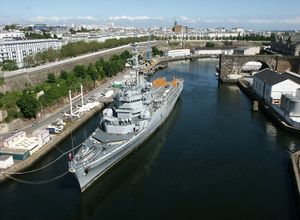
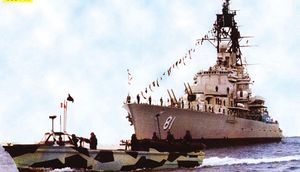
تصنيف الطرادات
كان تصنيف الطرادات يتم حسب الإزاحة، فالطراد الخفيف light cruiser لاتتجاوز إزاحته 10000 طن والطَّراد الثقيل heavy cruiser إزاحته أكثر من 10000 طن، ومع تسليح الطرادات بالصواريخ ظهر صنف جديد هو الطراد الخفيف ثقيل التسليح والصاروخي guided missile-heavy (light) cruiser.
وظهرت لدى الاتحاد السوڤييتي سابقاً الطرادات حاملة الحوامات، مثل: الطراد موڤكفا ومزوَّدة بأحدث أجهزة مكافحة الغواصات مع خمس عشرة حوامة كما ظهر في روسيا أيضاً الطراد القتالي battle cruiser مثل الطراد النووي طراز كيروف Kirov-class الذي يحمل ثلاث حوامات، و20صاروخاً عابراً للقارات، وأكثر من 150صاروخاً متنوعاً، إضافة إلى المدفعية والطوربيدات، وأسلحة مكافحة الغواصات، والأجهزة المساعدة التي تدير هذه النيران وتسيطر عليها.
آفاق مستقبلية
إن اتساع مسارح العمليات وضرورة البقاء لمدة طويلة في المحيطات والبحار يزيد من دور الطرادات المستقبلية، وتملك الولايات المتحدة الأمريكية اليوم أكثر من أربعين طراداً يعمل ثلثها بالطاقة النووية، ومسلحاً بأحدث الأجهزة والصواريخ المتطورة ذات الرؤوس النووية المتعددة، والمضادة للأهداف البرية والبحرية والجوية، فضلاً عن خطط تحديث مبرمجة حتى عام 2010، وتسعى أغلب الدول التي تتحمل ميزانيتها العبء المالي إلى تحديث الطرادات وبنائها بالتصنيف الذي تراه ضرورياً لمصالحها.
انظر أيضًا
المصادر
- ^ محمد قتيبة الصفدي. "الطَّرَّاد". الموسوعة العربية. Retrieved 2011-05-23.
- ^ Gardiner and Chumbley, pp. 350–354
- ^ Friedman cruisers, pp. 361–362
- ^ أ ب Friedman cruisers, pp. 378–382
- ^ Friedman destroyers, p. 301
- ^ Friedman destroyers, pp. 293–294
- ^ Friedman destroyers, pp. 297–298
- ^ Bauer and Roberts, p. 211
- ^ أ ب Bauer and Roberts, pp. 153–155
- ^ أ ب Bauer and Roberts, pp. 213–217
- ^ Friedman destroyers, pp. 300–304
- ^ Bauer and Roberts, pp. 154, 214
- ^ Friedman cruisers, p. 398, 422
- ^ Gardiner and Chumbley, p. 552
- ^ Friedman cruisers, pp. 398–400, 412
- ^ Gardiner and Chumbley, pp. 580–585
- ^ "Historic Navy Cruiser, USS Long Beach, To Be Auctioned As Scrap Metal By Government Liquidation Starting Tuesday, July 10". PR Newswire. 12 June 2012. Retrieved 26 January 2016.
- ^ Censer, Marjorie (18 September 2012). "Historic nuclear cruiser headed to scrap heap". The Washington Post. Retrieved 18 September 2012.
- ^ Gardiner and Chumbley, p. 380
- ^ Gardiner and Chumbley, p. 381
- ^ Gardiner and Chumbley, pp. 345, 381–382
- ^ "2017 China Military Power Report" (PDF). dod.defense.gov.
- ^ David Axe (23 February 2019). "Meet the Helicopter-Cruiser: The Half Aircraft Carrier". National Interest. Retrieved 14 June 2023.
المراجع
- STEPHEN SAUNDERS, Jane‘s Fighting Ships 2004-2005 (Jane‘s Information Group; 107th edition, 2004).
- BERNARD PREZELIN, The Naval Institute Guide to Combat Fleets of the World (Naval Institute Press 1995).
- RAY BONS, The US War Machines (Crown, New York 1983).



